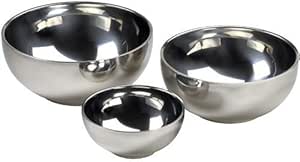How Stainless Steel Bowls Are Manufactured
From the humble kitchen staple to high-end laboratory equipment, stainless steel bowls are ubiquitous. But have you ever stopped to consider the journey a seemingly simple bowl takes from raw materials to its gleaming, finished state? The process is surprisingly intricate, involving a fascinating blend of precision engineering and skilled craftsmanship. Let’s delve into the world of stainless steel bowl manufacturing.
From Raw Material to Sheet Metal
The manufacturing process typically begins with stainless steel in the form of coils or sheets. The specific grade of stainless steel (e.g., 18/8, 304, or others) depends on the intended use of the bowl – food-grade bowls require different specifications than those used in industrial settings. These coils are incredibly long and wide, sometimes stretching hundreds of feet. The choice of stainless steel grade directly impacts the bowl’s durability, corrosion resistance, and overall lifespan.
The Precision of Blanking and Punching
The first major step in transforming the flat steel sheet into a bowl is blanking. This involves using a powerful press equipped with a precisely shaped die to cut out circular blanks—the raw, flat shapes that will eventually become bowls. The size and accuracy of these blanks are crucial; any imperfections will be amplified in the subsequent stages. This is followed by punching, where smaller holes (if needed) for handles or other features are created using another specialized die.
Hydroforming: Shaping the Metal

Hydroforming is a common method for shaping the metal blanks into the three-dimensional form of a bowl. This process uses high-pressure water or other fluid to push the metal blank against a precisely shaped die. The pressure and the die shape determine the final form of the bowl. This technique offers several advantages: it creates consistently shaped bowls, it can handle complex shapes, and it reduces material waste compared to some other techniques.
Spinning: An Alternative Shaping Method

While hydroforming is widespread, another prevalent method is spinning. In spinning, a circular metal blank is clamped onto a rotating mandrel (a precisely shaped form). A forming tool, held against the rotating blank, gradually shapes the metal into the desired form, much like a potter works with clay. Spinning allows for very precise shaping, and it’s often used for bowls with intricate curves or detailing.
Seaming and Welding: Joining Components
For bowls with handles or multiple parts, seam welding is a common method to join them. This specialized welding technique fuses the edges of the stainless steel pieces together to create a seamless, strong bond. The weld must be both strong and aesthetically pleasing, blending seamlessly with the overall bowl design. The quality of the welding is paramount to ensure the bowl’s durability and prevent leakage.
Finishing Touches: Polishing and Cleaning

Once shaped, the bowls undergo a finishing process to achieve the desired surface finish. This often involves polishing to create a smooth, lustrous surface. Various polishing techniques are used, ranging from manual buffing to automated processes, depending on the desired level of shine and the bowl’s design. The final step involves a thorough cleaning process to remove any manufacturing residue or imperfections.
Quality Control: Ensuring Excellence

Throughout the entire manufacturing process, rigorous quality control measures are employed. Inspections take place at each stage to identify and rectify any defects. This ensures that the final product meets the required standards for quality, durability, and safety. Modern manufacturing often incorporates automated inspection systems that can detect even minor flaws, further improving the efficiency and consistency of production.
Different Types of Stainless Steel Bowls and Their Manufacturing
The manufacturing process can vary slightly depending on the specific type of bowl being produced. For example, bowls with exceptionally deep draws or complex shapes might require more specialized techniques. Similarly, the surface finish (mirror-polished, satin-finished, etc.) affects the polishing stage of manufacturing. High-volume production lines tend to favor automated processes, while smaller-scale manufacturers may rely more on skilled manual techniques.
The Future of Stainless Steel Bowl Manufacturing
The industry is continually evolving, with innovations in material science, automation, and manufacturing techniques driving progress. Additive manufacturing (3D printing) is starting to find its niche in producing highly customized or complex bowl designs. Furthermore, the emphasis on sustainability is leading to the development of more environmentally friendly manufacturing practices. The future will undoubtedly see even greater precision, efficiency, and innovation in the creation of these everyday essentials.
Understanding the manufacturing process behind a simple stainless steel bowl reveals the intricate engineering and craftsmanship involved in producing a seemingly ordinary object. From the selection of raw materials to the final polishing, every stage contributes to the quality and durability of the finished product.


